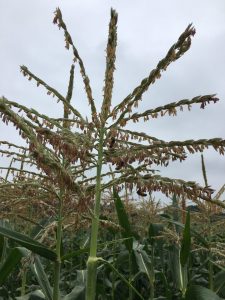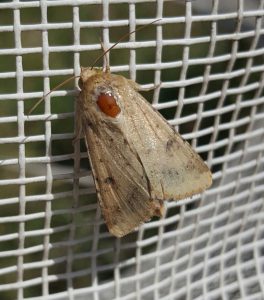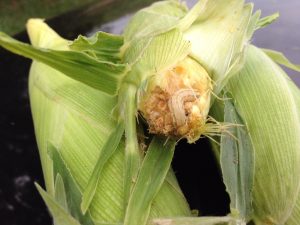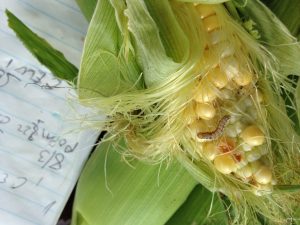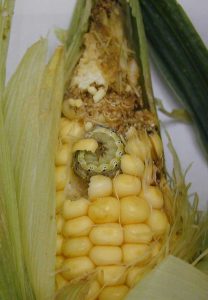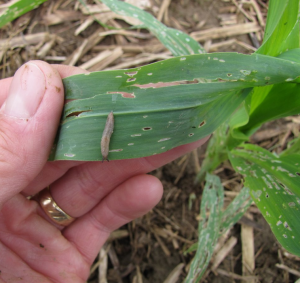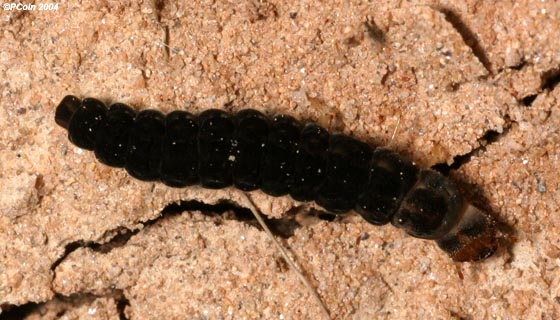Although corn is not insect pollinated, it doesn’t mean that it doesn’t attract a lot of bees gathering up pollen from the tassels (Fig. 1). Pyrethroid insecticides are quite toxic to bees, so spraying them during pollen shed will undoubtedly result in some bee kills. What can you do if you need to protect your corn from “worm” pests? Spraying an insecticide with low toxicity to bees (i.e., Coragen) during pollen shed can help. Also monitoring for pest activity and possibly limiting the number of sprays can also help.
Sweet corn farms are being monitored around Virginia for corn earworm and fall armyworm. Moth Trap Catch Data are being recorded by: Katlyn Catron (Montgomery Co.); Jason Cooper (Rockingham Co.); Ursula Deitch (Northampton Co.); Helene Doughty (Accomack Co. & Virginia Beach); Kenner Love (Rappahannock Co.); Laura Maxey Nay (Hanover Co.); Steve Pottorff (Carrol Co.); Stephanie Romelczyk (Westmoreland Co.); Laura Siegle (Amelia Co.); Rebekah Slabach (Halifax Co.); and Mark Sutphin (Frederick Co.).
This week we continued to observe high corn earworm moth catch at many locations, to warrant frequent spraying. Some of the areas with the highest CEW activity were on the Eastern Shore, Virginia Beach, Frederick Co., Montgomery Co. and Hanover Co. We still have not seen very many fall armyworm moths yet. For corn earworm, moth trap catch of less than 1 per night means low pest pressure and sweet corn sprays can probably be spaced 5-6 days apart during silking. However, a catch of >1 or >13 moths per night means moderate and high pest pressure, respectively, and a more frequent spray interval (every 3 or 2 days) is justified. Here are the trap catch results (moths per night) for several locations around Virginia for this week (note we do not have data for all locations):
| Week of Aug 13 (avg) | ||||
| Region | County | Field | CEW/night | FAW/night |
| Eastern Shore | Accomack | ESAREC – cemetery | 7.0 | NA |
| Eastern Shore | Accomack | ESAREC – woods | 0.2 | NA |
| Eastern Shore | Accomack | ESAREC – sweet corn | 19.7 | 0.2 |
| Eastern Shore | Northampton | Bridge Tunnel | 12.1 | NA |
| Eastern Shore | Northampton | Capeville 1 | 0.8 | 0.5 |
| Eastern Shore | Northampton | Cape charles | 1.2 | NA |
| Eastern Shore | Northampton | Eastville | 3.1 | 0.8 |
| Eastern Shore | Northampton | Nassawaddox | 0.1 | 2 |
| Virginia Beach | Virginia Beach | Pungo 1 | 16.1 | 0.7 |
| Piedmont | Amelia | Field 1 | NA | NA |
| Piedmont | Hanover | Farm 1 | 3.5 | 0.5 |
| Piedmont | Hanover | Haynes | NA | NA |
| Northern Neck | Westmoreland | Field 1 | 0.6 | 0.0 |
| Northern Neck | Westmoreland | Field 2 | NA | NA |
| Shenandoah Valley | Rappahannock | Field 1 | 2.8 | 0.2 |
| Shenandoah Valley | Page | Field 1 | 0.1 | 0 |
| Shenandoah Valley | Frederick | Farm 1 | 5.6 | 0 |
| Shenandoah Valley | Frederick | Farm 2 | 14.4 | 0 |
| Shenandoah Valley | Rockingham | Farm 1 | NA | NA |
| Shenandoah Valley | Rockingham | Farm 2 | NA | NA |
| New River Valley | Montgomery | KC | 0.9 | 0 |
| New River Valley | Montgomery | KO1 | 4.9 | 0 |
| New River Valley | Montgomery | KO2 | 9.4 | 0 |
| New River Valley | Montgomery | WF1 | 1.1 | NA |
| New River Valley | Montgomery | WF2 | 0.6 | NA |
| New River Valley | Montgomery | WF3 | 0.7 | NA |
| New River Valley | Montgomery | WS1 | 2.4 | NA |
| New River Valley | Montgomery | WS2 | 0.9 | NA |
| New River Valley | Montgomery | WS3 | 2.6 | NA |
| Southwest | Carroll | NA | NA | |

